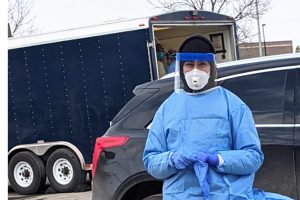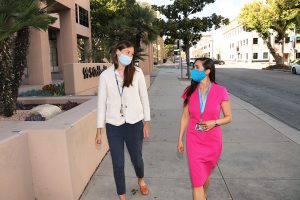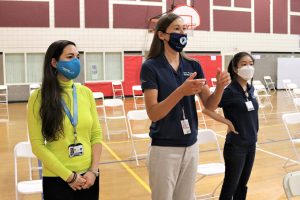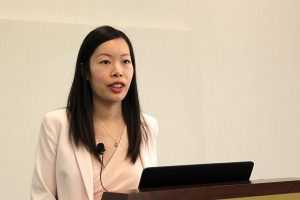Feature story:
CDC disease detectives build bridges to national COVID-19 response
In February 2020, Lisa Oakley, PhD, MPH was in Ghana assisting with a polio vaccination campaign when she heard the news about COVID-19 on TV. “We were seeing the cases in Wuhan, seeing the beginning of the pandemic play out,” she said. “I suspected it would be hitting us about the time I got back home, but I had no idea how big it would become.”
For Dr. Oakley, “back home” meant returning to Kaiser Permanente Southern California, where she was “embedded” in the Department of Research & Evaluation as an Epidemic Intelligence Service (EIS) officer for the Centers for Disease Control and Prevention (CDC). She was only the second EIS officer assigned to work with Kaiser Permanente, in a position created just a few years before.
 EIS officers, better known as CDC disease detectives, spend 2 years serving at various training sites throughout the country, mostly at CDC headquarters in Atlanta or in public health departments throughout the country. KPSC is the only site in the country where an EIS officer works within a health care delivery system rather than a governmental organization.
EIS officers, better known as CDC disease detectives, spend 2 years serving at various training sites throughout the country, mostly at CDC headquarters in Atlanta or in public health departments throughout the country. KPSC is the only site in the country where an EIS officer works within a health care delivery system rather than a governmental organization.
In general, the role of these disease detectives is to investigate the sources and spread of disease and devise innovative approaches to prevention and control. An EIS officer working within KPSC has the unique opportunity to work alongside the organization’s research epidemiologists and clinicians, blending the investigation of infection with the delivery of health care directly to Kaiser Permanente members.
“I was able to work with researchers and clinicians to explore health on the larger population level, looking at how we can protect our members all around, and not just when they come in to see the doctor,” said Dr. Oakley, who now works as an epidemiologist at the CDC. “From that perspective, Kaiser Permanente is truly practicing a public health approach.”
Bringing experience back to colleagues
During their 2-year experiential training, EIS officers may be called upon to respond to an urgent public health need, outside of their initial assignment. Dr. Oakley was no exception, deploying not only to Ghana, but then to Seattle, on a mission that turned out to be incredibly important in the early days of the COVID-19 pandemic.
In Seattle, she served on a team of CDC infection prevention and control experts alongside the Seattle-King County Public Health Department as part of the first efforts to test asymptomatic residents and health care workers in long-term care facilities.
“We started getting a sense that the situation was going to be bigger than we anticipated it would be,” she said about the data they were collecting. “It really was a time of learning how the virus is transmitted and what kind of symptoms are associated with it.”
As a result of this investigation, Dr. Oakley co-authored one of the first publications describing COVID-19 transmission among people who weren’t showing symptoms. That finding has become vital to the public health response in this pandemic. She then went to North Dakota, where she investigated an outbreak of COVID-19 in a long-term care facility and guided testing strategies to help the employer quickly identify people who were infected and isolate them from other staff and residents.
Once she returned to California, Dr. Oakley developed strategies to support Kaiser Permanente members across the nation sharing households with residents who had tested positive for COVID-19 infection. In these consultations, she advised members how to isolate, how to appropriately wash hands and wear masks, and how to safely carry out other essential household activities.
“I was so fortunate to have gained the experience of supporting this emergency response,” said Dr. Oakley. “It really informed my understanding of how to support members at an early stage when we didn’t have a lot of information about virus transmission within a household.”
Passing the torch
Dr. Oakley’s tenure as an EIS officer at KPSC ended in June 2020 as she completed her EIS fellowship. During her last few months, she joined another regional team that laid the groundwork for a digital COVID-19 surveillance tool that proactively prompts members regarding symptoms and triages them for appropriate care via text or email. When Dr. Oakley’s successor, Debbie Malden, DPhil, MSc, took the reins in August, she sprang into action as disease detectives do, linking up with a group of colleagues who were just piloting the tool among Kaiser Permanente members in Washington state. 
“I was able to jump in at the right time and with the right skill set to help them meet their goal of reaching more members to capture the real-time prevalence of COVID-19 symptoms, particularly among members who have typically been under-represented in medical research involving digital health interventions previously,” said Dr. Malden, who came into EIS equipped with a background in epidemiology.
The digital surveillance tool, known as the Voluntary Symptom Reporting tool, or VSR, queries Kaiser Permanente members via text or email (based on the member’s preference) asking if they’re experiencing COVID-19 symptoms. If they are, the tracker asks more questions to triage the member appropriately, sometimes to a physician for consult or to the emergency department.
Collaboration with IT proved invaluable
One aspect of the project that was particularly exciting for Dr. Malden was being able to bring the VSR tool to full potential by working with Kaiser Permanente’s seasoned information technology experts and platforms.
“I got to work hand in hand with the software engineers and make recommendations from a public health standpoint,” she said. “The collaboration between Kaiser Permanente IT and the Community Health team was truly remarkable. The team’s ability to approach the VSR project with tactful creativity and a bold application of novel techniques, together with their unified drive to improve health, was inspiring. It felt like, working together, we could really enhance the design of the tool for the benefit of public health at large. It was a real team effort.” 
Dr. Malden presented the VSR tool to her EIS colleagues at the CDC in the fall. “It was really valuable not only to gather opinions from my fellow EIS officers but also to see what they’ve been doing and to get input from them and the surveillance experts across the agency,” she said, noting that she was able to incorporate that input when making improvements to the VSR tool. “The main finding is that it’s feasible to target texts and emails, get responses in real time, and communicate with members in a way that affects their behavior and their interaction with the health care services,” she said. “And this is independent of what information we’re trying to record.”
In other words, the symptom reporter can be used in any public health context, regardless of the disease or symptoms being tracked. In fact, the work done for the VSR laid the groundwork for the Kaiser Permanente COVID-19 Side Effect Monitoring System, which was implemented in 2021 as part of a collaboration with the CDC. Dr. Malden’s supervisor, Sara Tartof, PhD, MPH, who herself went through the EIS fellowship before joining KPSC, couldn’t be prouder of her trainee’s work.
“What this means, essentially, is that our Kaiser Permanente EIS officer is able to leverage work and models done by Kaiser Permanente in other regions into a similar system the CDC is developing that could ultimately have a worldwide impact,” Dr. Tartof said. “Both Lisa and Debbie have been a really important link between the CDC and Kaiser Permanente on COVID-19 efforts.”
EIS alums advocate for KPSC position
When Dr. Tartof was an EIS officer, she and her then-colleague Jean Lawrence, ScD, MPH, MSSA—also a CDC EIS alum—were instrumental in the creation of the EIS officer position at KPSC. Being familiar with the EIS fellowship, they knew that such a collaboration had enormous potential. “The caliber of professionals in the EIS fellowship is really tremendous,” Dr. Tartof said. “They’re highly trained and really motivated. And this position allows them to see how their work can impact population health through a variety of avenues, including patient care. It’s not an academic exercise here. It has real medical and public health value.”
After several years of discussion within KPSC and with the CDC, the role was created in 2016. The next step, Dr. Tartof said, was to recruit one of those highly trained and motivated officers to fill it. Dr. Tartof described the recruitment process as something resembling medical residency matching: representatives from the host sites sit at tables and answer questions from prospective recruits, after which the EIS officers are matched with one of the host sites that suits their training needs and expectations.
It was challenging to find an officer willing to take the plunge on a newly created position, said Dr. Tartof, especially given that KPSC was (and still is) the only site unaffiliated with local, state, or federal government. “There was no history. We couldn’t answer questions about what the experience had been like for previous officers,” she said.
A unique opportunity
But Drs. Tartof and Lawrence successfully matched with Gloria Chi, PhD, MPH, a newly minted PhD graduate from the University of Washington. Dr. Chi recognized that, with access to Kaiser Permanente’s electronic health records and research expertise, she could take on investigations that wouldn’t be possible in other places. Combining that opportunity with the chance to be a government representative working in a non-governmental environment elevated the potential. “I could see how the position would enable me to conduct research that applied directly to improving health care and health care delivery,” said Dr. Chi.
 Dr. Chi came to the new position with an interest in investigating the health impacts of environmental pollutants. “Even though that type of data isn’t usually available in medical records, using Kaiser Permanente’s data we were still able to conduct a study in that area.”
Dr. Chi came to the new position with an interest in investigating the health impacts of environmental pollutants. “Even though that type of data isn’t usually available in medical records, using Kaiser Permanente’s data we were still able to conduct a study in that area.”
For example, during her tenure from 2016 to 2018, shortly after lead was discovered in the water in Flint, Michigan, Dr. Chi was able to study trends in blood lead levels in children living in the KPSC region and create a more streamlined process for getting kids from across the region tested.
Reflecting on valuable KPSC experience
The richness and accuracy of Kaiser Permanente’s data has been a draw for Drs. Chi, Oakley, and Malden. That data, layered on top of the opportunity to collaborate and do field work with health officials in the country’s most populous county, makes a good argument for an EIS “datahead” to choose Kaiser Permanente as their host site.
Dr. Chi said that combining that data with the skills of an EIS officer really helps bring out the potential for new understanding. “You can have a lot of data, but analyzing it isn’t always straightforward,” she said. “Having an EIS officer working in R&E allows that person not only to access the data, but to address research questions that have direct relevance to clinical practice.”
Now a senior data scientist at Genentech, Dr. Chi said that every day, she employs the data analysis skills she learned during her time with KPSC.
Dr. Oakley agrees. Reflecting on her time spent as a CDC disease detective with Kaiser Permanente, both before COVID-19 and during the public health response, she said the EIS position is a real opportunity for public health and health care systems to learn from each other. “I was able to bring my experience from boots-on-the-ground CDC deployments back to inform my work at Kaiser Permanente, just as my population-level health research in the Division of Epidemiologic Research helped to inform my work in the field.”
“Building stronger relationships between health care and public health serves to strengthen the whole system,” she said.





